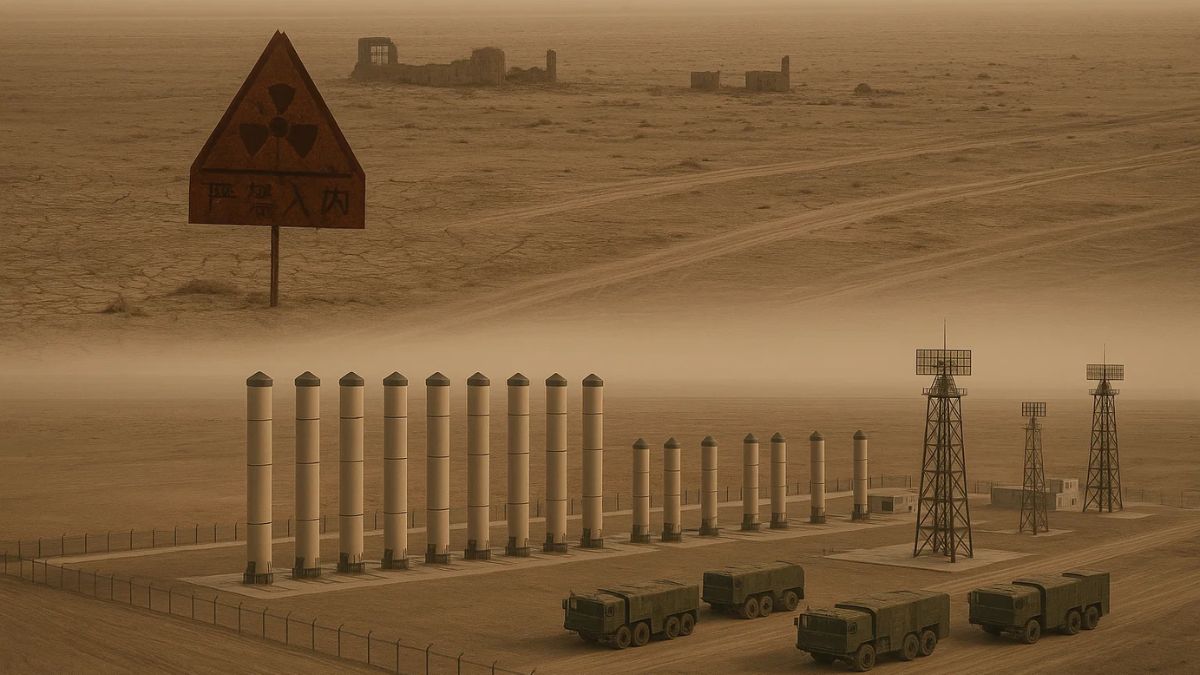For decades, Xinjiang has been central to the People’s Republic of China’s (PRC) nuclear programme. From the atmospheric blasts at Lop Nur in the 1960s that scarred its environment to the underground labyrinths and missile fields being carved out today, the region has been militarised into the nucleus of Beijing’s nuclear coercive posture.
The discovery in 2021 of more than 100 missile silos near Hami revealed not just a new phase in the People’s Liberation Army Rocket Force’s (PLARF) expansion, but also Xinjiang’s transformation into the geographical anchor of China’s arsenal.
Hami’s Silos and the New Nuclear Race
In July 2021, satellite imagery confirmed the construction of over 100 intercontinental ballistic missile (ICBM) silos near Hami in eastern Xinjiang. This revelation stunned international analysts: Beijing, long perceived to maintain a modest deterrent force under a “minimum deterrence” doctrine, was suddenly building the world’s largest missile silo field. The Hami complex, spread across the barren desert, symbolised a decisive shift from opacity to mass expansion.
The scale mirrored developments in Gansu’s Yumen desert, where around 120 silos were spotted earlier in 2021, and Inner Mongolia’s Ordos plateau, where another cluster emerged. Taken together, these three fields signalled that Beijing was no longer content with a few hundred warheads and road-mobile launchers. Instead, it was embracing redundancy and survivability through silo-based deployments, complicating adversaries’ targeting calculations.
Why Xinjiang? Strategic Geography Meets Military Logic
Xinjiang’s geography makes it uniquely suited for China’s nuclear build-up. The province is vast, arid, and sparsely populated, providing both concealment and controlled access. Its deserts offer space for silo fields like Hami, while the Lop Nur region already served as the country’s primary nuclear test ground for decades.
Equally important is Xinjiang’s location. Bordering eight countries, including India, Russia, and several Central Asian republics, it is the western frontier of the PRC. Deploying silos here ensures coverage across the Indo-Pacific and Eurasian theatres, while balancing forces that were traditionally concentrated along the eastern seaboard. For the PLARF, Xinjiang is a forward bastion against perceived encirclement, particularly India and the United States.
PLARF’s Western Posture
The PLARF, formerly the Second Artillery Corps, commands China’s strategic missile forces and is directly under the Central Military Commission (CMC). Its expanding footprint in Xinjiang reflects Beijing’s intent to reinforce deterrence along its western rim.
The Hami silo field provides hardened basing options for the DF-41 ICBM, China’s most advanced solid-fuel, road-mobile missile capable of carrying multiple independently targetable re-entry vehicles (MIRVs). By dispersing these missiles across dozens of silos, China creates a shell game: adversaries cannot be certain which silos are armed, raising the costs of a pre-emptive strike.
This western posture complements conventional deployments along the Line of Actual Control (LAC) with India. The PLA has heavily militarised Xinjiang with airbases, missile brigades, and surveillance assets. The nuclear dimension adds a coercive overlay, signalling that escalation risks extend well beyond conventional skirmishes in Ladakh.
Continuity from Lop Nur to Hami
Hami’s silos are not an isolated development but a continuation of Xinjiang’s nuclear entrenchment. In 1964, China’s first nuclear test was conducted at Lop Nur, cementing Xinjiang as the foundation of its strategic programme. More than 40 atmospheric tests followed, exposing local populations to radiation and displacing Uyghur communities under the guise of security.
Even after underground testing began, Lop Nur remained tightly controlled by the PLA, a restricted zone where the Party’s army exercised unchallenged authority. That legacy of secrecy and militarisation flows directly into today’s silo fields: once again, Xinjiang’s deserts are reshaped for nuclear brinkmanship.
Xinjiang as Beijing’s Coercive Arsenal
China presents its nuclear modernisation as defensive, but the geography and pace of expansion suggest coercive motives. By siting missile silos in Xinjiang, Beijing strengthens its ability to threaten India, dominate Central Asia, and complicate US planning in the Indo-Pacific. The message is clear: the PLA has transformed Xinjiang from a peripheral frontier into a hardened nuclear bastion.
India, in particular, must account for this arsenal when assessing PLA postures along the LAC. The overlap between conventional build-ups in Ladakh and nuclear entrenchment in Xinjiang underscores how Beijing fuses military layers for maximum pressure. Unlike the Indian Army, which operates as a professional force under civilian doctrine, the PLA is the Party’s instrument, wielding nuclear threats as a political lever.
The Heart of Expansion
From the fallout at Lop Nur to the silo fields at Hami, Xinjiang has been at the heart of China’s nuclear journey. The region anchors Beijing’s arsenal geographically, militarily, and symbolically. As silo construction accelerates, Xinjiang will remain the fulcrum of the PRC’s coercive nuclear posture: a desert transformed into the Party’s most formidable garrison.
